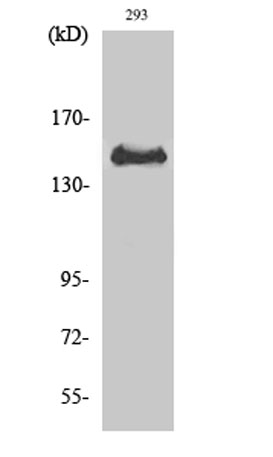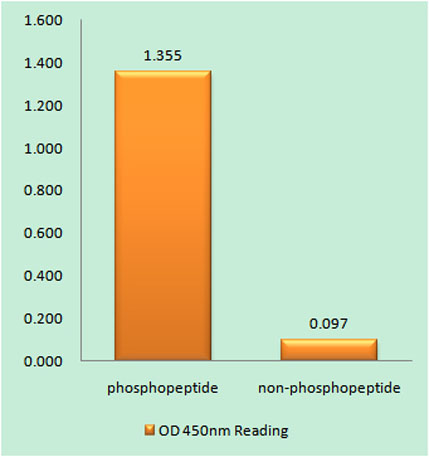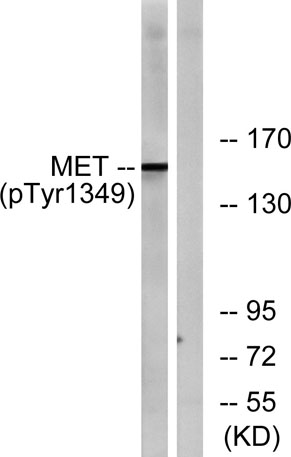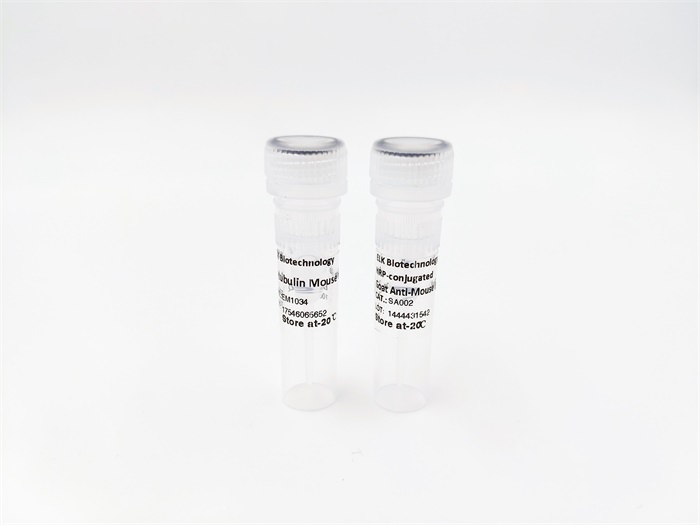









Met (phospho Tyr1349) rabbit pAb
 One-click to copy product information
One-click to copy product information$148.00/50µL $248.00/100µL
| 50 µL | $148.00 |
| 100 µL | $248.00 |
Overview
| Product name: | Met (phospho Tyr1349) rabbit pAb |
| Reactivity: | Human;Mouse;Rat |
| Alternative Names: | MET; Hepatocyte growth factor receptor; HGF receptor; HGF/SF receptor; Proto-oncogene c-Met; Scatter factor receptor; SF receptor; Tyrosine-protein kinase Met |
| Source: | Rabbit |
| Dilutions: | WB 1:500-2000;IHC-p 1:50-300; ELISA 2000-20000 |
| Immunogen: | The antiserum was produced against synthesized peptide derived from human Met around the phosphorylation site of Tyr1349. AA range:1316-1365 |
| Storage: | -20°C/1 year |
| Clonality: | Polyclonal |
| Isotype: | IgG |
| Concentration: | 1 mg/ml |
| Observed Band: | 155kD |
| GeneID: | 4233 |
| Human Swiss-Prot No: | P08581 |
| Cellular localization: | Membrane; Single-pass type I membrane protein.; [Isoform 3]: Secreted. |
| Background: | This gene encodes a member of the receptor tyrosine kinase family of proteins and the product of the proto-oncogene MET. The encoded preproprotein is proteolytically processed to generate alpha and beta subunits that are linked via disulfide bonds to form the mature receptor. Further processing of the beta subunit results in the formation of the M10 peptide, which has been shown to reduce lung fibrosis. Binding of its ligand, hepatocyte growth factor, induces dimerization and activation of the receptor, which plays a role in cellular survival, embryogenesis, and cellular migration and invasion. Mutations in this gene are associated with papillary renal cell carcinoma, hepatocellular carcinoma, and various head and neck cancers. Amplification and overexpression of this gene are also associated with multiple human cancers. [provided by RefSeq, May 2016], |
-
 Western Blot analysis of various cells using Phospho-Met (Y1349) Polyclonal Antibody diluted at 1:1000
Western Blot analysis of various cells using Phospho-Met (Y1349) Polyclonal Antibody diluted at 1:1000 -
 Enzyme-Linked Immunosorbent Assay (Phospho-ELISA) for Immunogen Phosphopeptide (Phospho-left) and Non-Phosphopeptide (Phospho-right), using Met (Phospho-Tyr1349) Antibody
Enzyme-Linked Immunosorbent Assay (Phospho-ELISA) for Immunogen Phosphopeptide (Phospho-left) and Non-Phosphopeptide (Phospho-right), using Met (Phospho-Tyr1349) Antibody -
 Western blot analysis of lysates from HepG2 cells, using Met (Phospho-Tyr1349) Antibody. The lane on the right is blocked with the phospho peptide.
Western blot analysis of lysates from HepG2 cells, using Met (Phospho-Tyr1349) Antibody. The lane on the right is blocked with the phospho peptide. -
 Immunohistochemical analysis of paraffin-embedded human Colon cancer. 1, Antibody was diluted at 1:200(4° overnight). 2, Tris-EDTA,pH9.0 was used for antigen retrieval. 3,Secondary antibody was diluted at 1:200(room temperature, 45min).
Immunohistochemical analysis of paraffin-embedded human Colon cancer. 1, Antibody was diluted at 1:200(4° overnight). 2, Tris-EDTA,pH9.0 was used for antigen retrieval. 3,Secondary antibody was diluted at 1:200(room temperature, 45min).

 Manual
Manual